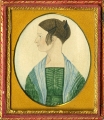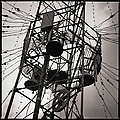| May 2, 2015 | Frederick Gutekunst: Scenery on the Pennsylvania Rail-Road
(ca 1875) | | | |
Album of photographs documenting the Philadelphia, Middle, and Pittsburgh divisions of the Pennsylvania Railroad, incorporated in 1846. The consolidated company sought to build a trunk route from Philadelphia to Pittsburgh through the Allegheny mountains in order to compete with the Erie Canal for freight traffic. In 1854, rail passage through the Alleghenies via the "Horse Shoe Curve" was achieved and spurred the establishment and growth of the several towns depicted along the route.
This album has been kindly provided by The Library Company of Philadelphia. With the assistance of Sarah Weatherwax, Curator of Prints and Photographs and Nicole Joniec, Digital Collections Manager. Many thanks.

PhVTitle | Lightbox | Checklist
Exhibition: Frederick Gutekunst: Scenery on the Pennsylvania Rail-Road (ca 1875)
More about this photographer
| 
| | May 1, 2015 | Samuel Bourne: India | | | |
Samuel Bourne (1834-1912) was born in Shropshire, England. As a young man he became a keen amateur photographer exhibiting work at the Nottingham Photographic Society Exhibition in 1858. He arrived in India in January of 1863 at which point he undertook the arduous journey from Madras to Simla and the foothills of the Himalayas.
In Simla he met up with William Howard, who was a professional photographer in Simla and became a partner in the photographic business that Howard had already established. Shortly after, they were joined by Charles Shepherd and the partnership of Bourne and Shepherd was begun. Howard left the company in 1866.
Bourne‘s photographic journeys of 1863 into the Himalayas, 1864 to Kashmir and his second trip to the Himalayas in 1865/66 form what is considered his finest body of work. The dramatic photographs of these remote and almost inaccessible regions help make his name as a true artist and the premier photographer of the Indian sub-continent.
In the short space of seven years he produced in excess of 2,200 superb images of the landscape and architecture of the country. We are indeed fortunate that the quality of his prints was such that many fine examples of his work have survived. The popularity of Indian photography owes a lot to the wonderful images that Samuel Bourne produced.
Bourne left India November 1870, never to return.

PhVTitle | Lightbox | Checklist
Exhibition: Samuel Bourne
More about this photographer
| 
| | Apr 11, 2015 | Staircases | | | |
The analysis of how a single architectural element has been photographed since the dawn of photography reveals a lot about stylistic trends.

PhVTitle | Lightbox | Checklist
Exhibition: Architecture: Staircases
| 
| | Apr 11, 2015 | Early photographs of American Folk Art from the David A. Schorsch collection | | | |
Early photographs of American folk paintings constitute a unique archive of works by both recognized and unknown artists, frequently even preserving a visual record of otherwise unknown paintings. A large number of early daguerreotypists practiced this lucrative work at a time when photography afforded Americans their first opportunity to have accurate copies of works of art, especially much desired copies of portraits of family members lost to death or distance. These copy images vary greatly in quality and interest, from mere duplicates to works of art in their own right. Between 1840 and 1860 most were produced by three photographic methods—as daguerreotypes, ambrotypes, and tintypes, each of which produced a single copy. By 1860, negative-based cartes-de-visite, inexpensive and readily available in multiples, effectively wiped out the earlier techniques. Surviving advertisements, broadsides, trade cards, and labels document that photographers from itinerant practitioners to the most famous studios in major cities offered copy work.

PhVTitle | Lightbox | Checklist
Exhibition: Early photographs of American Folk Art from the David A. Schorsch collection
| 
| | Apr 11, 2015 | Structural Steel | | | |
Structural steel made skyscrapers possible, it provided the framework for the Eiffel Tower and the Marseille Transborder bridge so beloved by Modernist photographers including Herbert Bayer, Germaine Krull, Man Ray, Marcel Bovis, Brassai, François Kollar, André Steiner, Tim Gidal and László Moholy-Nagy. The contrasting voids of steel and sky and their height encouraged an upward vision and those changes in viewpoint became embedded in avant-garde and Modernist photography.

PhVTitle | Lightbox | Checklist
Exhibition: Structural Steel
| 
| | Apr 11, 2015 | The Haj | | | |

PhVTitle | Lightbox | Checklist
Exhibition: The Haj
| 
| | Mar 28, 2015 | The Next Phase | | | | In the last Newsletter (Vol 9.01, March 27, 2015) the current scale of Luminous-Lint was outlined and it now includes:
58,000 photographs from all periods and regions of the world
2,600 public and private collections have supplied material
17,932 photographer names included for 7,428 different photographers
1,120 themes with their own continually improving histories of photography [Subscribers]
3,800 fragments with over 5,000 footnotes to support the themes [Subscribers]
8,254 references to books, articles and conference papers [Subscribers]
1,381 online exhibitions (online or in planning)
The real power is in the millions of interconnections throughout Luminous-Lint. The next phase will be the creation of Online Exhibitions that address some of the gaps in the overall framework. If you have a suggestion for a Theme do send it through.
|
| | Dec 28, 2014 | Jean-Gabriel Eynard | | | |
Drink a glass of Kirsch or Damassine to celebrate the birth of Jean-Gabriel Eynard...
(1775, 28 December - 1863, 5 February)
Early Swiss photographer who took Daguerreotype studies of his family and servants.
More about this photographer
| 
| | Dec 28, 2014 | Ed Van der Elsken | | | | Raise a glass to the memory of Dutch photographer Ed Van der Elsken...
(1925, 10 March - 1990, 28 December)
Highly respected Dutch photographer who produced a vast range of books and films covering his travels around the world. Between 1950 and 1954 he lived in Paris and documented the love life of Ann (the real life painter Vali Myers) and the photographs were published in the 1956 photobook classic "Love on the Left Bank" (Holland: Export printing office W. vonk).
More about this photographer
| 
| | Dec 26, 2014 | Henri Le Secq | | | | Raise a glass of absinthe to the memory of Henri Le Secq...
(1818, 18 August - 1882, 26 December)
Early French photographer who used waxed paper negatives. His finest works are the architectural shots he took for the ‘Commission des Monuments Historiques‘.
More about this photographer
| 
|
Ongoing • Newest • Newer • Older • Oldest Mode: LL C_NEWS_CF
|

